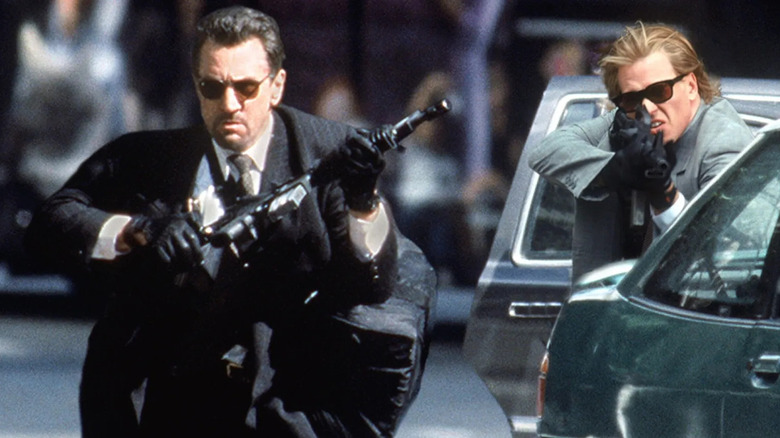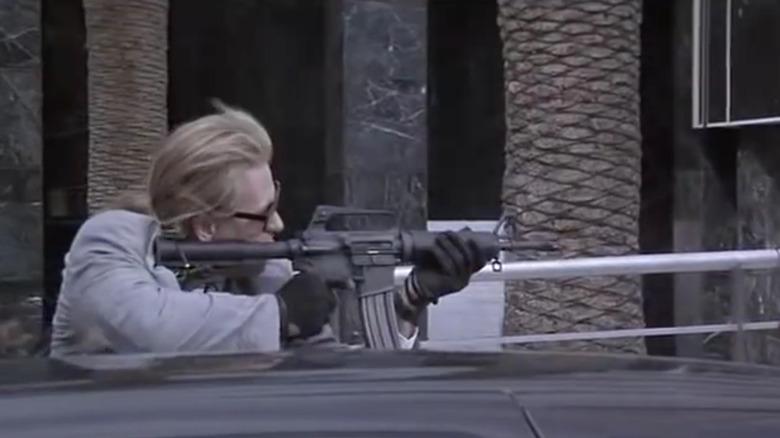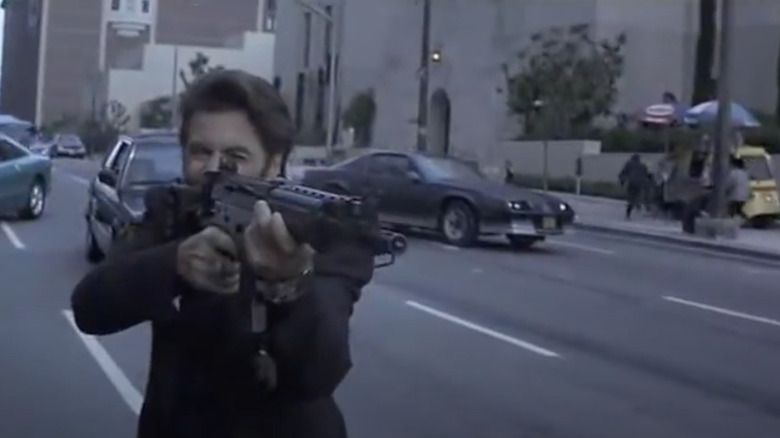How Michael Mann Made Heat's Massive Shootout Work
If you ever make an action movie with Michael Mann, you'd better be ready to dance.
According to the writer-director of "Heat," choreographing the film's epic shootout in Downtown Los Angeles was precisely like staging a musical number. He doesn't mean "choreography" in a hyper-stylized John Woo sense, but rather in terms of logistics. Though the sequence is covered with handheld cameras to make it seem ferocious and wholly spontaneous, it is meticulously organized chaos. From the minute the gunmen hit the street, they know exactly where they have to be at every single moment, much like the Jets and the Sharks hitting their marks in "West Side Story." Their movements might appear effortless, but they're the result of months of training — and given the length of the shootout, none of this training could be done on the streets of L.A.
Val Kilmer's quick on the draw and the reload
The rehearsal period for the shootout began with Mann and company setting up shop in three target ranges owned by the L.A. County Sheriff's Department. Per Mann:
"We built a true-scale mock-up of the actual location we were using along 5th Street in downtown L.A., with flats and barriers standing in for where every parked car was going to be, every mailbox, every spot where De Niro, Tom Sizemore, and Val Kilmer were going to seek cover as they moved from station to station."
Mann rehearsed his actors until every single movement was second nature, and they more than rose to the challenge. Talk to anyone who's been through basic military training, and they will heap the highest of praise on Val Kilmer's combat technique, particularly the moment where, taking cover behind a cop car with his Colt M4, he swaps out a spent magazine in five seconds. It's a textbook reload. Just as impressive is the way he instinctively points his rifle skyward as he shifts back and forth so as not to accidentally fire on one of his colleagues.
A dance of death
This situation is highly unusual and precarious for the LAPD. As Mann explains, "Judged strictly in terms of scene analysis and character motivation, the police are used to entering a situation with overwhelming power on their side. When they're assaulted by people who know what they're doing, they don't do well." It's a frightening place for the cops to be, and Mann relates this sense of anxiety to the viewer by using the cacophonous location audio from the day of the shoot. If there was ever a massive gun battle in downtown Los Angeles (actually, there was an eerily similar one two years later in North Hollywood), this is how it would look and sound: bullets whizzing back and forth as the report of the firearms echo off the concrete and skyscrapers. It's urban warfare.
Mann's most impressive achievement in the execution of this sequence might be the way he keeps the audience focused on McCauley's objective. These men aren't trying to go down in a blaze of glory; they're trying to get the hell out of a tight situation with the loot they just heisted from the bank. This tension resonates throughout, and because we understand these characters as more than criminals, part of us wants them to get away scot free.
Mann went on to craft a number of captivating shootouts in films like "Collateral," "Miami Vice" and "Public Enemies," but the sequence in "Heat" towers above all of them. It's a brilliant, brutally effective piece of filmmaking that directors have been chasing over the last 27 years. But when it comes to staging a firefight with this degree of verisimilitude, no one dances like Michael Mann.


